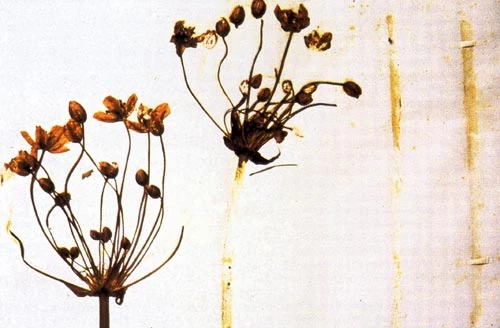Moth Balls and Arsenic, Booklice and Silverfish - Hazards of the Museum Herbarium
Specimen showing attack by biscuit beetle.
Testing for mercury vapour levels inside the herbarium cupboards.
An example of pesticide discolouring. Research showed that this specimen had been treated with arsenic, mercury and barium - substances harmful to both specimen and health.
Amgueddfa Cymru house over quarter of a million dried plant specimens from all over the world, some dating back to the 18th century. Toxic pesticides applied to these specimens over the years can cause damage to the specimens and be a risk to those working with them.
Pesticides are applied to the specimens to overcome pests such as booklice, biscuit beetle and silver fish. Natural history specimens have always been vulnerable to attack from pests, which can be devastating to a botanical collection, as important details, or even whole specimens, can be lost.
Some types of pesticides used in the past are now known to be harmful and toxic. Handling the collections could present a health risk, especially as the quantity and nature of chemicals used in the pesticide were unknown.
Small samples of the Museum's herbarium sheets were analysed to detect the chemicals present within one sample. For example, if mercury and arsenic had been applied to a herbarium sheet then this would identify the two metals in one test.
It was discovered that the most frequently used chemicals were carbon disulphide, mercuric chloride, methyl bromide, naphthalene, paradi-chlorobenzene and pyrethroids.
Mercury
High levels of mercury were found within the paper samples and immediate precautions were taken for handling specimens. Mercury can be absorbed through inhalation, absorption and ingestion and its effects can result in reduced fertility, possible genetic mutations, shakes, reduced vision, serious personality changes and even brain damage.
The herbarium air quality was monitored for mercury vapour and each site tested had readings well below the recommended health and safety standard. Individuals were monitored by attaching the monitoring instruments directly to their clothing.
Moth Balls and Arsenic
Although it is difficult to measure arsenic accurately, it was discovered on most of the specimens tested. The presence of naphthalene was detected on all samples, which was as expected. Moth balls, made from naphthalene, were only removed from herbarium cupboards in the 1980s.
The project successfully identified the hazardous chemicals and metals present within the pesticide residues and through continued monitoring of air quality and staff, work can now continue within the herbarium without risk.
Following the tests, a database was generated detailing specimens, pesticide, contaminants and risks to both health and the specimens, which has since been used to help identify hazards in herbariums from other botanical institutions.


